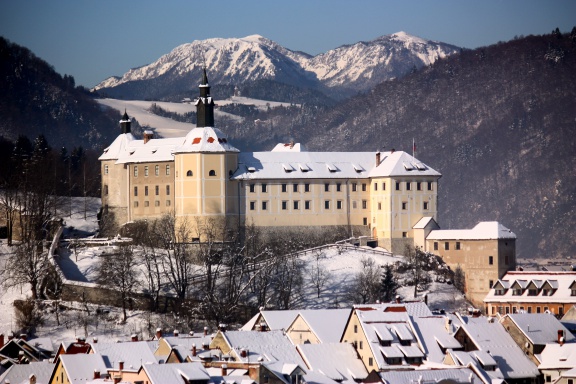Loka Museum, Škofja Loka
-
23 Oct 2014
A lecture on the legacy of Bauhaus and Avgust Černigoj and their role in contemporary practices by Barbara Sterle Vurnik (Loka Museum, Škofja Loka) at the international symposium Bauhaus in the Life and Work of Selman Selmanagić
Programme
The museum documents, collects, preserves, and protects natural and movable cultural heritage from the Škofja Loka region. It cooperates with other organisations and communities as well as with private owners of cultural collections in order to present the collections and to offer them expert help. It carries out a wide range of educational activities for all age groups, such as workshops, lectures, and guided tours through its exhibitions.
It manages three venues, France Mihelič Gallery, Ivan Grohar Gallery, Cankar Battalion Memorial Room in Dražgoše, and an open-air museum at castle park. In 2007 a permanent ethnological exhibition was settled in Dražgoše.
History
In 1936 an exhibition on crafts and industry took place in Škofja Loka and soon after the local Museum Society was founded. The society's goal was to collect as many works of art and antiques as possible in the town and its environs, and simultaneously to obtain suitable premises to exhibit these objects, which came true in Škofja Loka town hall in 1939, when establishing the Loka Museum.
In 1946, after World War II, the Loka Museum was allocated its own premises in Puštal Castle, in which the collections were exhibited. In 1959 the museum moved to its present location in Loka Castle. The collections were renovated several times with the major changes in 1999 and 2012.
Collections
Major exhibitions include a collection of archaeological artefacts dating back to the Bronze Age; an important collection of medieval documents, which includes the donation deed of 973 from Emperor Oton II to Bishop Abraham which confirms that the Loka territory (the river basins of both Sora Rivers and the Sora Plain) belonged to the Bavarian Bishopric of Freising for no less than 830 years; the famous Škofja Loka Passion Play of 1721, Slovenia's oldest preserved drama text; two Renaissance inscription slabs from 1513, one of which, depicting the Škofja Loka coat-of-arms, bears witness to the reconstruction of the town after the earthquake; and a guilds collection which presents the heritage of the Loka guilds, the oldest being those of tailors, shoemakers, furriers, and potters (deeds, small chests, jugs, a signet ring, banners, and signboards).
Archaeological collection
The archaeological collection is presented to the public with three themes. The Settlement of the Loka Territory in the Archaeological Periods presents the items from the Stone Age to 973 AD; mediaeval town artefacts are presented with Upper Tower on Krancelj and the Town Square Komun and with Loka's Painted Bourgeois Ceramics.
Art history collection
The art history collection comprises works of art dating from the 14th century onwards. The core of the presentation of medieval art in the ground-floor corridor consists of numerous copies of frescoes from the churches of Suha, Križna gora, and Crngrob; from the latter originates the famous Holy Sunday fresco, created by the workshop of Janez Ljubljanski during the mid-15th century, which depicts Christ suffering on the cross, surrounded by instruments of torture, and scenes from the everyday life of peasants, craftsmen, merchants, and nobles.
In the castle chapel, four gilded altars are presented, originating from the church of Dražgoše, which was burnt down in 1942. The altars illustrate the development of woodcarving in the region in the 17th century from a mannerist architectural design to richly-decorated High Baroque altars.
The works of painters, natives from Škofja Loka, form a special collection, exhibited in the first-floor corridor – mainly the work of the Šubic family of wood sculptors and painters from Poljane (Štefan, Janez Sr, Janez Jr, Valentin, Jurij, Rajko, Mirko, and Ive Šubic). Ivan Grohar, Ivan Franke, France Košir, Maksim Sedej, Gvidon Birolla, and Gojmir Anton Kos are also represented in the collection.
Ethnological collection
The ethnological collection of Loka Museum is one of the largest in Slovenia and has no less than 16 sections which present the life of peasants and burghers in Škofja Loka before industrialisation. Exhibits comprise objects used in the past in agriculture and cattle breeding, in the preparation of food and in transportation. The open-hearth kitchen displays tools and accessories related to cooking and baking, as well as various old lamps.
Special attention is given to trades that used to be crucial for the survival of Loka inhabitants: bobbin-work for lace, the sieve maker's trade, the hat trade, the linen trade, dyeing and printing linen, the making of artificial flowers, and the baking of decorated honey pastries ("mali kruhek"), a traditional speciality of Loka made of honey dough, shaped in models or by hand.
Cultural history and recent history displays
Other important exhibitions include a cultural history display, which presents a survey of the development of education in the Loka region with facsimiles of the Škofja Loka Maniscript and the Škofja Loka Passion Play. The native, politician, and writer Ivan Tavčar (1851–1923) and his legacy are displayed in a separate room, furnished with Kalan's furniture from Visoko, a setting place of Tavčar's novel Visoška kronika. To the cultural history collection also belongs a collection of burgher ceramics from the 16th and 17th centuries and the documentation of the Škofja Loka Passion Play performances in 1936 and 1999.
A recent history collection presents the Loka region in the 20th century. Activities during World War I, the strike actions between 1935 and 1936, the Dražgoše battle during World War II, and the national liberation movement are some of the topics presented.
Natural history collection
At the northern wing the biggest natural history collection in Gorenjska is placed, which exhibits the fauna of the Loka region, including fish, reptiles, birds, mammals, beetles, and butterflies.
See also
- Loka Castle
- France Mihelič Gallery, Škofja Loka
- Ivan Grohar Gallery, Škofja Loka
- Škofja Loka Passion Play
- Sokolski dom Culture Centre, Škofja Loka
- Historical Archives Ljubljana: Škofja Loka Unit
- Capuchin Monastery Archives and Library, Škofja Loka
- Gorenjska Museum
External links
- Loka Museum, Škofja Loka website
- Museum Society Škofja Loka website
- Museum, Škofja Loka on Virtual Guide to Slovene Museums and Galleries
- About Janez Ljubljanski, see chapter 1.1.2
- Ivan Tavčar on Wikipedia
- Open-air museum panoramas on Virtual Guide to Slovene Museums and Galleries
- Škofja Loka panoramas, for castle see the west points
- Loka Castle – kraji.eu




